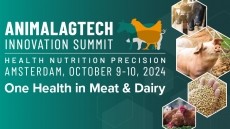Porcine plasma may help solve post-weaning problems in piglets, boost their well-being

During the weaning transition period, piglets have increased diarrhea incidence but decreased growth performance, which will ultimately cause animal welfare issues and significant economic losses, said the authors, writing in the December 2021 edition of Animal Nutrition
In the livestock industry, antibiotic growth promoters (AGP) have been used as an effective tool for decreasing diarrhea and improving growth in weaning piglets for decades (Nofrarías et al., 2006), said the team, which included an employee of Sonac (China) Biology Co, one of the funders of the research.
They also noted that a therapeutic dosage of zinc oxide (ZnO), from 2,000 to 4,000 mg/kg in piglets' complete feed, can decline the colonization and population of pathogens in the intestine, resulting in decreased post-weaning diarrhea and increased growth performance (Shelton et al., 2011; Cho et al., 2015).
“Hence, AGP and pharmacological levels of ZnO are widely adopted in weaning piglets' diets to reduce post weaning diarrhea and promote growth performance.”
However, antimicrobial resistance (AMR) is increasingly becoming a global threat for human health, which is leading to a global shift away from the use of AGP in feeds, commented the team.
They also reported that the EU will impose a ban on the use of pharmacological doses of ZnO for piglets from June next year, following on from reports it contributes to environmental pollution and an increase in AMR. Although to date the EU is imposing the strictest regulations on ZnO in piglet production, other markets are also starting to reduce the levels of ZnO in piglet diets, said the team.
Therefore, it is of great importance to find an environmentally friendly strategy to solve the post-weaning problems in piglets and increase their well-being, argue the researchers.
Spray-dried plasma protein
Animal spray-dried plasma protein (SDP), such as spray-dried porcine plasma protein (SDPP) and spray-dried chicken plasma protein (SDCP) are complex mixtures, containing fibrinogen, immunoglobulin and albumin (Jiang et al., 2000), wrote the team.
“Having abundant IgG and good palatability and digestibility (Pierce et al., 2005; Ermer et al., 1994; Dijk et al., 2001; Zhang et al., 2015), SDP has been used in piglets' diet and shown to be capable of promoting intestinal development, resisting the challenge of bacterial pathogens, changing the volatile fatty acids (VFA) profile, reducing diarrhea incidence and improving piglets’ growth around the weaning transition period (Zhang et al., 2015; Gao et al., 2011; Tran et al., 2018; Che et al., 2020; Peace et al., 2011).
“However, it is still obscure whether dietary SDPP or SDCP has comparable effects to ZnO plus antibiotics in post-weaning piglets,” they commented.
Methodology
This study was, therefore, conducted to investigate the effects of SDPP or SDCP supplementation in diets without the inclusion of antibiotics and zinc oxide (ZnO) on growth performance, fecal score, and fecal microbiota in early-weaned piglets.
The experiment was run over 14 days.
A total of 192 healthy weaning piglets were blocked by body weight (BW) and randomly assigned to four dietary treatments: negative control (NC, basal diet), positive control (PC), basal diet + ZnO at 2g/kg and antibiotics at 0.8 g/kg), SDPP (containing 5% SDPP), and SDCP (containing 5% SDCP).
The spray-dried plasma in SDPP and SDCP groups replaced fish meal in the basal diet of the NC and PC groups, said the researchers.
The diets, which were iso-proteinic, iso-energetic and balanced for amino acid requirements, were pelleted in a commercial feed mill.
All the piglets were weighed individually at the beginning and end of the experiment after removing the feed for 12 hours, and the feed consumption per pen was recorded daily throughout the experiment, outlined the authors.
On the basis of the data above, average BW, average daily gain (ADG), average daily feed intake (ADFI), and gain-to-feed ratio (G:F) were calculated.
Fecal scoring was visually observed each morning and afternoon by an observer blinded to the treatments according to Sun et al. (2008) and modified with industry practice, they said.
Fresh excreta were ranked based on the following scale: 0 = solid; 1 = semi-solid; 2 = semi-liquid; 3 = liquid. Piglets were defined as having diarrhea when feces score was 3.
Findings
The team saw that the SDPP group had higher final BW, average daily gain and average daily feed intake than the NC and SDCP groups.
The percentage of piglets with fecal scores at 2 or ≥2 was higher in the NC and SDCP groups than in the PC group.
A decreased bacterial alpha diversity and Bacteroidetes abundance, but increased Firmicutes abundance were observed in the PC and SDPP groups when compared to the NC group.
The relative abundance of Lactobacillus was higher in the SDPP than in the SDCP group, and that of Streptococcus was higher in the PC and SDPP groups than in the NC group.
The PC group also had higher Faecalibacterium abundance than the NC and SDCP groups.
Additionally, the SDCP group had higher serum urea nitrogen than those fed other diets, and lower short-chain fatty acids to branched-chain fatty acids ratio than the PC and SDPP groups.
“Overall, SDPP was a promising animal protein for piglets in increasing feed intake, modifying gut microbiota profile, reducing gut protein fermentation and alleviating diarrhea frequency, thus promoting growth performance, under the conditions, with limited in-feed utilization of antibiotics and ZnO,” they concluded.
Source: Animal Nutrition
DOI: https://doi.org/10.1016/j.aninu.2021.05.008
Title: Differential responses of weaned piglets to supplemental porcine or chicken plasma in diets without inclusion of antibiotics and zinc oxide
Authors: Z Fang et al


















